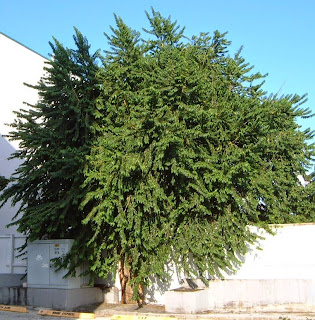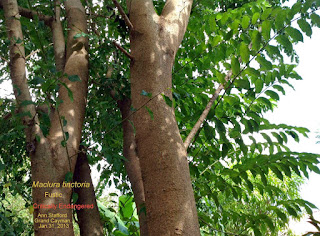Fustic - Maclura tinctoria (L.)
Don ex Steud. (synonym: Chlorophora tinctoria),
Family: MORACEAE
Khaki dye tree
by P. Ann van B. Stafford
Fustic tree - Maclura tinctoria is Critically Endangered in the Cayman
Islands.
Fustic is native to the
West Indies and continental tropical America, to Argentina. It grows in Grand Cayman and Cayman Brac. It is DIOECIOUS - male and
female flowers grow on separate trees. Fruits are borne on the female trees
only, which must be sufficiently close to receive pollen from a tree with male
flowers in spikes or catkins.
FLORA of the CAYMAN ISLANDS by George R. Proctor 2012, p. 241. Fig. 84.
Cayman Islands RED LIST Native Flora
Female Fustic tree at the Agricultural Grounds
in Lower Valley, Jan. 13, 2002

It is a culturally significant Cayman tree - i
t was exported from Grand
Cayman from the mid-1700’s to the early 1800’s for its yellowish
dye, known as fustic or khaki, which was extracted from the wood. It was used
to dying military uniforms and schoolboys clothing.
1765 Royal Navy officers Remark Books provide information about Cayman. HMS Active anchored off Grand Cayman. Captain Robert Carkett noted that there were about 20 families, most of whom cut Mahogany (Swietenia mahagoni) and Fustic (Maclura tinctoria) which were exported to Jamaica.
Female Fustic tree branch bearing fruits - edible, but not very palatable,
adjacent to Grand Palms condos, by Point Four, South Church St, Nov. 1, 2003
Fustic tree on Cayman Islands Stamps First Day Cover -
Cultural Series Part I - TREES, Feb.23, 2006.
Fustic tree (female) in a garden on Conch Point Road, West Bay, Grand Cayman, Oct. 20, 2002.
Caycar Apartments stepwell, Denham Thompson Way,
close to the male and female Fustic trees in Harts' horse pasture and Point Four.
A young Fustic tree was growing in the well with the ferns.
After Hurricane Ivan (Sept. 2004), rubble was dumped into the well and it was grassed over.
The unmarked historic stepwell lies hidden beneath the lawn.
Ann Stafford, Nov. 1, 2003.
Young Fustic tree in the very rocky Ironwood Forest, George Town, Grand Cayman,
Nov. 13, 2006.
Juvenile Fustic leaves
Ann Stafford, Grand Cayman, April 24, 2005.
'Old Lady Fustic' - female Fustic tree, behind the old West Wind Building
(between the present Flagship Building and Butterfield Bank), Oct. 12, 2003.
Offspring of "Old Lady Fustic" by a drain in the parking lot, April 24, 2005.
Two were rescued by the late Lois Blumenthal.
'Old Lady Fustic' - female Fustic tree, behind the old West Wind Building
(between the present Flagship Building and Butterfield Bank), July 28, 2006.
'Old Lady Fustic' getting squeezed out by encroaching construction, July 28, 2006.
Fustic is DIOECIOUS - male and female flowers grow on separate trees.
Pistillate - female flowers in rounded heads.
The aggregate fruits are fleshy and edible, but not very palatable. Ann Stafford, West Bay, Grand Cayman, Oct.20. 2002.
Female rounded flower heads, aggregate fruit.
Ann Stafford, Agricultural Grounds, Lower Valley, Grand Cayman, May 17, 2015.
Excerpts from Jim Conrad's Naturalist Newsletter. Yucatán, México:
"The greenish "hairs" on
the above "fruits" are styles, which are the "necks" connecting
pollen- receiving stigmas or stigmatic surfaces with the ovaries. Each of the "fruits" in the picture is technically a collection of many actual fruits packed
very closely together."
Fustic tree (female) at the end of Leafy Lane, off Walkers Road, Aug. 28, 2005.
Fustic tree (female) at the end of Leafy Lane, off Walkers Rd, George Town, Jan. 31, 2011.
The path leads to Goring Avenue.
Fustic tree (female) at the end of Leafy Lane - STUMPED, gone, May 17, 2015.
Fustic tree (female), Bodden Road, Grand Cayman, Oct. 9, 2003
Fustic tree (female), Bodden Road, Grand Cayman, May 20, 2015
Fustic tree, King Road, West Bay, Grand Cayman, Oct. 20, 2002.
Fustic tree (male) in our George Town garden, Jan, 31, 2013
 |
| Fustic tree (male) in our George Town garden, April 18, 2014 |
Fustic is DIOECIOUS - male and female flowers grow on separate trees.
Staminate - male flowers - catkins.
Ann Stafford, South Church St, Grand Cayman, Oct.20. 2002.
Male Fustic tree opposite the Central Police Station in George Town,
behind Godfrey's Enterprises, July 28, 2006.
Male Fustic tree opposite the Central Police Station in George Town,
behind Godfrey's Enterprises, May 17, 2015.
Fustic catkins on male tree, Nov. 1, 2003
Felled Fustic tree along track parallel to Newport Ave. George Town, Grand Cayman, Feb.1, 2006.
Cayman Islands Orchid Society members searching for Critically Endangered Ghost Orchids (Dendrophylax fawcettii)
amongst the recently felled trees, including Critically Endangered Fustic (Maclura tinctoria).
Much more very rocky original growth forest was cleared than that which was built on.
Wildlife interactions
Fustic is a larval food plant of the Fig Sphinx moth - Pachylia ficus, Family: SPHINGIDAE. Fustic belongs to the same Family: MORACEAE as Wild Fig - Ficus aurea, a well-known larval food plant of Fig Sphinx.
Pachylia ficus - Fig Sphinx Moth, Costa Rica
Maclura tinctoria is shown as a larval food plant.
Fig Sphinx moth - Pachylia ficus larva, feeding on a
Fustic tree - Maclura tinctoria, Family: MORACEAE, Critically Endangered, in a private garden.
Fustic belongs to the same family as Wild Fig - Ficus aurea,
known larval food plant of Fig Sphinx.
Photo: Yves-Jacques Rey-Millet, Jan. 27, 2013
All stages of the moth are shown.
Blue-throated Anole Lizard - Anolis conspersus conspersus lives in Fustic tree.
Grand Cayman, April 3, 2011.
Habitat light, colour variation and ultraviolet reflectance in the Grand Cayman Anole, Anolis conspersus
Joseph M. Macedonia
"Data from a diversity of sources are consistent with the hypothesis that the Grand Cayman anole, Anolis conspersus , is descended directly from Anolis grahami of Jamaica. Although the two species have remained morphologically similar, coloration in A. conspersus has changed considerably from that of its ancestor. The most dramatic difference is seen in dewlap colour, where A. conspersus
has evolved a blue and highly UV-reflective dewlap from the ancestral
orange-and-yellow colour state. In addition, variation in normal
(non-metachrosis) dorsum coloration in A. grahami populations is limited to shades of green (olive, emerald, teal), whereas in A. conspersus
dorsum coloration varies from green to blue and to brown. This
increased colour variation occurs despite Grand Cayman being a small,
relatively featureless island only 35 km in length. Results of this
study suggest that ambient light differences associated with
precipitation-related vegetation structure may have played an important
role in the evolution of A. conspersus body colour variation."
"...three "color morphs" (green, brown, and blue).."
Smooth-billed Ani, locally called Black Arnold or Old Arnold - Crotophaga ani -
communal nest, high up in Fustic tree in a George Town garden, April 3, 2014.
Anis eat Fig Sphinx moth caterpillars.
Fustic uses
The wood is very tough and close-grained. Fustic was exported from Grand
Cayman from the mid-1700’s to the early 1800’s for its yellowish
dye, known as fustic or khaki, which was extracted from the wood. It was used
to dying military uniforms and schoolboys clothing.
Cayman Cub Scouts in their khaki uniforms marching in the St. George's Day Parade
along the George Town waterfront, April 27, 1975.
Historically used for wooden wheels and mill rollers, suitable for furniture and cabinet work; railroad ties; smoking pipes; previously exported as a dye for khaki; bark reportedly medicinal (Mabberley 1997). p.277.
Argentine Osage Orange - Maclura tinctoria
The
wood is very durable and has good weathering characteristics; it is also resistant
to termites.
Heavy
construction (within the tree’s natural range), flooring, furniture, turnings,
and other small specialty wood items.
Old
fustic was used extensively from about 1600
to 1850, as it produces a strong colour at low cost. During the WW1, fustic was one of the main dyes
used to produce khaki for army
uniforms.
Conservation
Fustic tree (female) off South Church St, May 26, 2004
House plans were modified so that the tree was preserved.
The same female Fustic tree after the house was built, Oct.8, 2005.
The same female Fustic tree, May 20, 2015.
Fustic - Maclura tinctoria, Useful Tropical Plants


















































